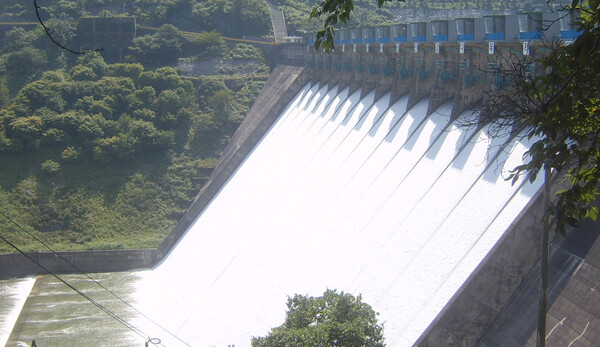딥 러닝(Deep Learning) 기술 이용 댐 운영 패턴 분석하고 그 실효성 검증
수자원 분야 국제 학술지 ‘저널 오브 하이드롤로지(Journal of Hydrology)’에 게재

수년간의 가뭄 이후 집중호우가 내렸던 2020년 8월, 섬진강 인근 댐의 물을 방류하는 과정에서 강이 범람해 1천억 원(약 7천600만 달러) 이상의 피해가 발생했다. 수해 원인은 당시 댐의 수위를 평소보다 6m가량 높게 유지했기 때문이다. 미리 이 상황을 예측하고 댐을 관리했다면 충분히 막을 수 있지 않았을까?
최근 포항공과대학교(POSTECH, 이하 포스텍) 환경공학부 감종훈 교수·통합과정 이은미 씨 연구팀은 딥 러닝(Deep Learning) 기술을 이용해 댐 운영 패턴을 분석하고, 그 실효성을 검증했다. 이번 연구는 수자원 분야 국제 학술지 중 하나인 ‘저널 오브 하이드롤로지(Journal of Hydrology)’에 게재됐다.
우리나라는 강수가 여름에 집중되어 댐 등의 시설로 물을 관리한다. 그러나 세계적 기후 위기로 예상치 못한 태풍과 가뭄이 반복되며 댐 운영에 어려움을 겪고 있다. 이를 극복하기 위해 최근 기존 물리적 모델에서 나아가 빅데이터를 학습한 인공지능(artificial intelligence, 이하 AI) 모델을 활용한 새로운 연구가 시도되고 있다.
연구팀은 AI 모델로 섬진강 유역에 있는 댐들(섬진강댐, 주암댐, 주암조절댐)의 운영 패턴을 예측하고, 또 어떻게 댐 수위를 예측하는지 설명가능한 시나리오를 개발하는 데 주목했다.
![이번 연구를 주도한 포스텍 환경공학부 감종훈 교수(왼쪽)와 통합과정 이은미 씨. [사진출처(Photo source) = 포항공과대학교(POSTECH)]](https://cdn.waterjournal.co.kr/news/photo/202311/72004_43854_1456.jpg)
포스텍 김종훈 연구팀은 2002년부터 2021년까지 섬진강 인근 댐의 데이터로 딥 러닝 알고리즘 중 하나인 게이트 반복 단위(Gated Recurrent Unit, 이하 GRU) 모델을 학습시켰다. 이때, 댐의 강수량과 유입량, 유출량 데이터를 입력값으로, 시간당 댐 수위를 출력값으로 사용했다. GRU 모델을 통한 분석은 효율성 지수 0.9 이상의 높은 정확도를 보였다.
이어, 연구팀은 입력값들을 -40%, -20%, +20%, 40%로 조절하며 설명가능한 시나리오들(Explainable Scenarios)을 디자인했다. 또 이를 활용해 학습된 GRU 모델이 입력값들의 변화에 따라 어떻게 수위를 결정하는지 분석했다.
강수량의 변화에 대해서는 댐의 수위가 크게 변하지 않은 반면, 댐을 통한 유입량 변화에 따라 댐 수위가 크게 변했다. 또한, 같은 유출량 변화에도 댐마다 다른 수위 변화를 확인해 각 댐의 운영 방식을 GRU 모델이 학습한 것을 확인했다.
학습된 모델을 사용한 댐 수 위 예측
![[그림출처(picture source) = 포항공과대학교(POSTECH)]](https://cdn.waterjournal.co.kr/news/photo/202311/72004_43855_1551.png)
감종훈 교수는 “AI 기술로 댐 운영 방식과 패턴을 분석하고, 실효성을 검증했을 뿐 아니라 지금까지 AI 기반 블랙박스 모델(Black Box Model)로 어떻게 댐 수위를 결정하는지 간접적으로 이해하는 방법론을 제시했다”며, “앞으로 댐 운영 방식을 이해하고 효율적으로 운영하는 데 도움이 되기를 바란다”고 말했다.
한편, 이번 연구는 한국연구재단의 중견연구자지원사업의 지원으로 진행됐다.
[원문보기]
POSTECH Professor Jonghun Kam’s team leveraged artificial intelligence models to enhance dam operations
In August 2020, following a period of prolonged drought and intense rainfall, a dam situated near the Seomjin River in Korea experienced overflow during a water release, resulting in damages exceeding 100 billion won (USD 76 million).
The flooding was attributed to maintaining the dam’s water level 6 meters higher than the norm. Could this incident have been averted through predictive dam management?
A research team led by Professor Jonghun Kam and Eunmi Lee, a PhD candidate, from the Division of Environmental Science & Engineering at Pohang University of Science and Technology (POSTECH), recently employed deep learning techniques to scrutinize dam operation patterns and assess their effectiveness. Their findings were published in the Journal of Hydrology.
Korea faces a precipitation peak during the summer, relying on dams and associated infrastructure for water management. However, the escalating global climate crisis has led to the emergence of unforeseen typhoons and droughts, complicating dam operations.
In response, a new study has emerged, aiming to surpass conventional physical models by harnessing the potential of an artificial intelligence (AI) model trained on extensive big data.
The team focused on crafting an AI model aimed at not only predicting the operational patterns of dams within the Seomjin River basin, specifically focusing on the Seomjin River Dam, Juam Dam, and Juam Control Dam, but also understanding the decision-making processes of the trained AI models.
Their objective was to formulate a scenario outlining the methodology for forecasting dam water levels. Employing the Gated Recurrent Unit (GRU) model, a deep learning algorithm, the team trained it using data spanning from 2002 to 2021 from dams along the Seomjin River.
Precipitation, inflow, and outflow data served as inputs while hourly dam levels served as outputs. The analysis demonstrated remarkable accuracy, boasting an efficiency index exceeding 0.9.
Subsequently, the team devised explainable scenarios, manipulating inputs by -40%, -20%, +20%, and 40%, of each input variable to examine how the trained GRU model responded to these alterations in inputs. While changes in precipitation had a negligible impact on dam water levels, variations in inflow significantly influenced the dam’s water level.
Notably, the identical change in outflow yielded different water levels at distinct dams, affirming that the GRU model had effectively learned the unique operational nuances of each dam.
[출처=포항공과대학교(POSTECH)(https://www.postech.ac.kr/eng/dams-now-run-smarter-with-ai/?pageds=1&k=&c=) / 2023년 11월 15일]
[번역 = 배철민 편집국장 겸 글로벌물산업정보센터장]

